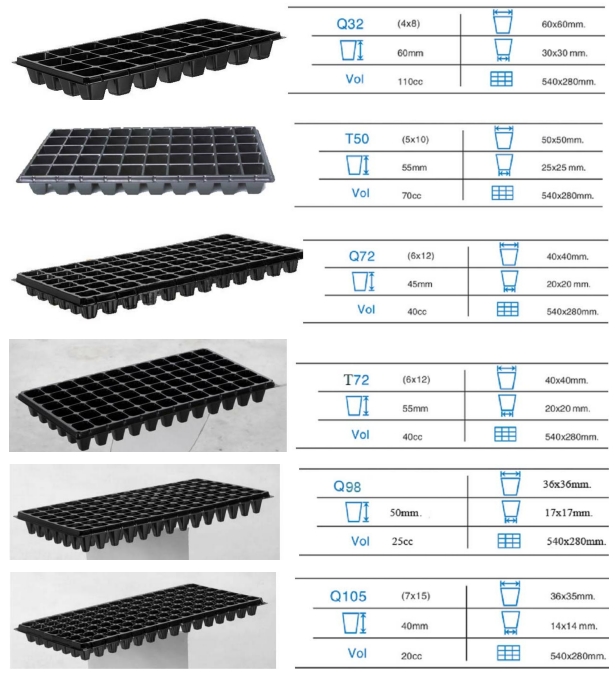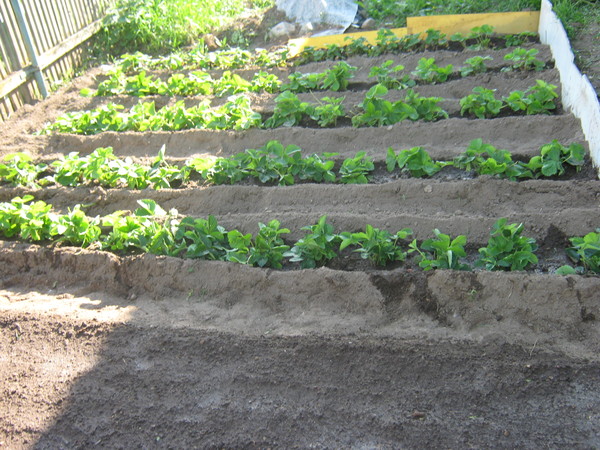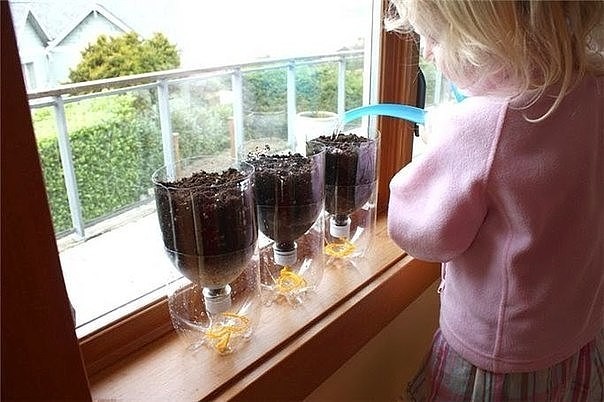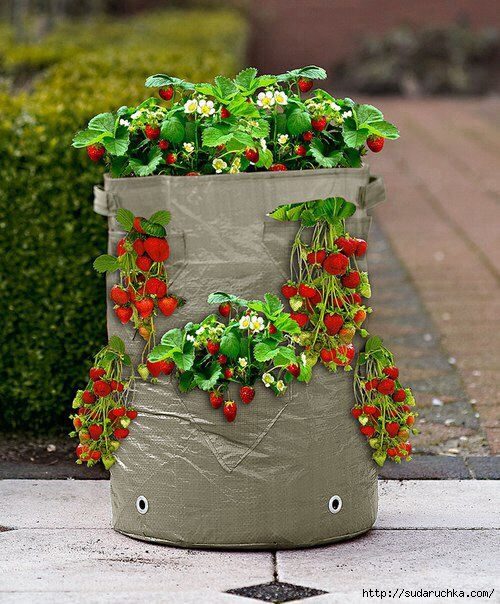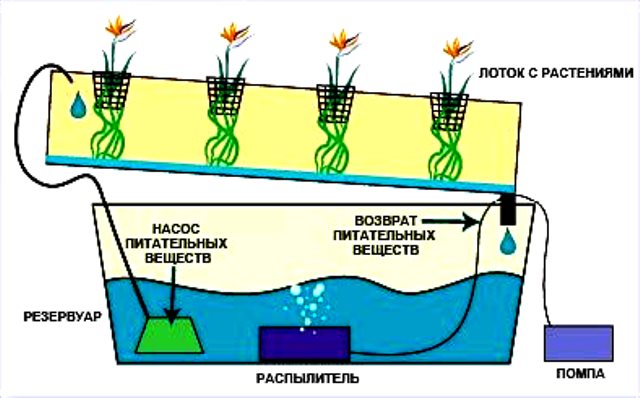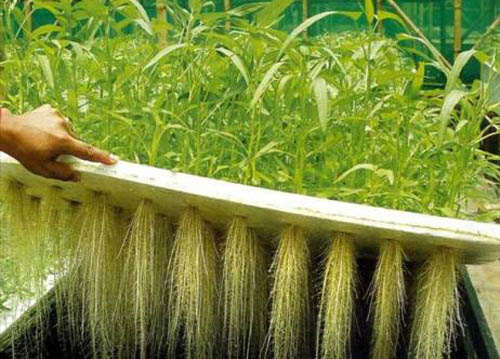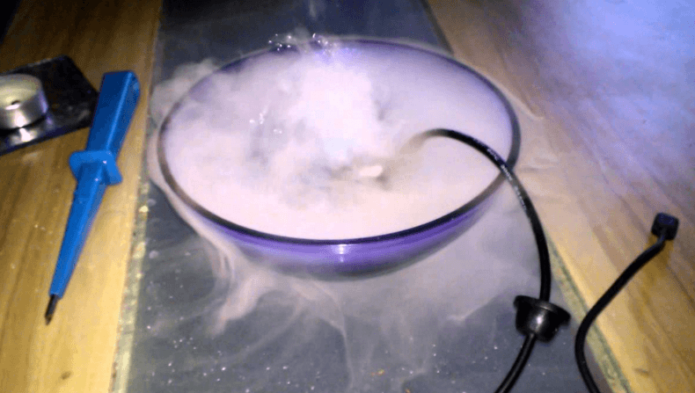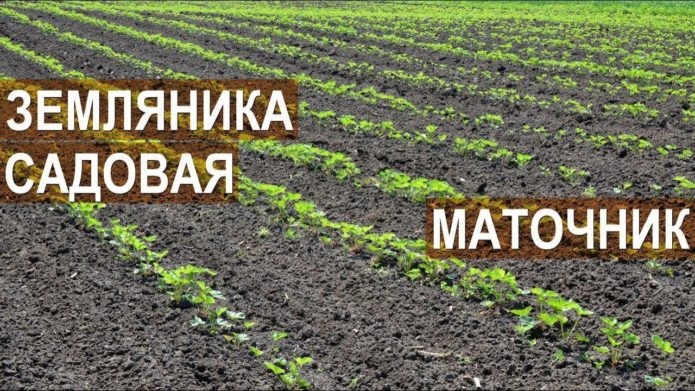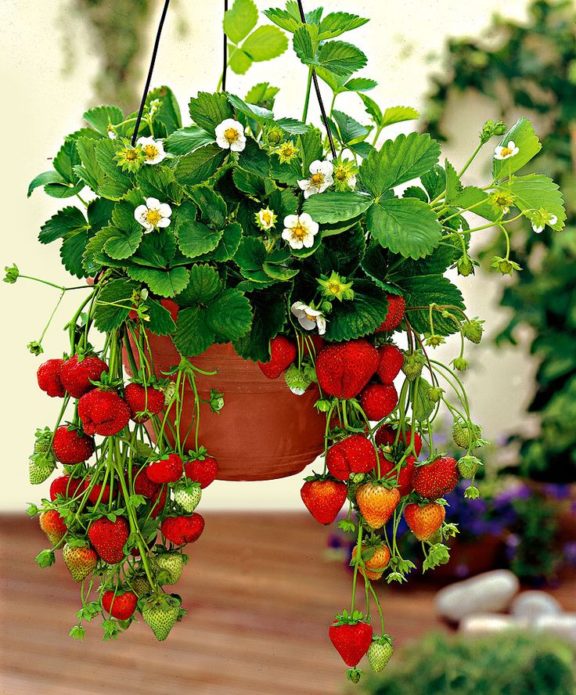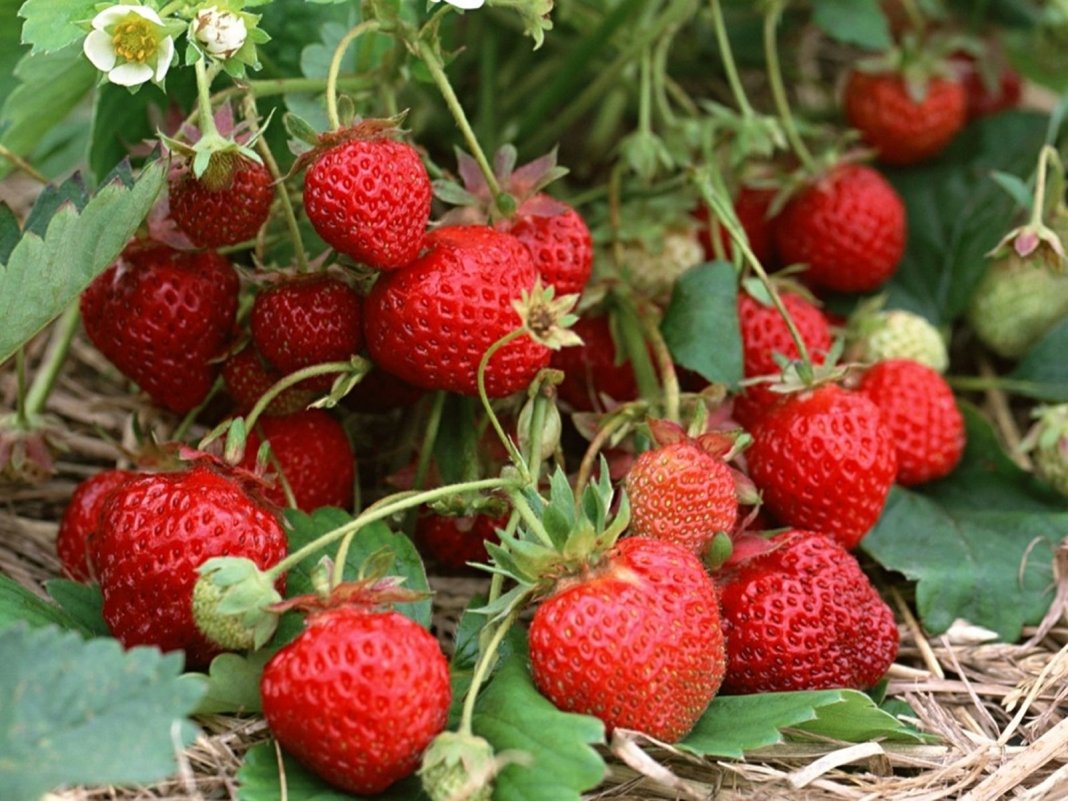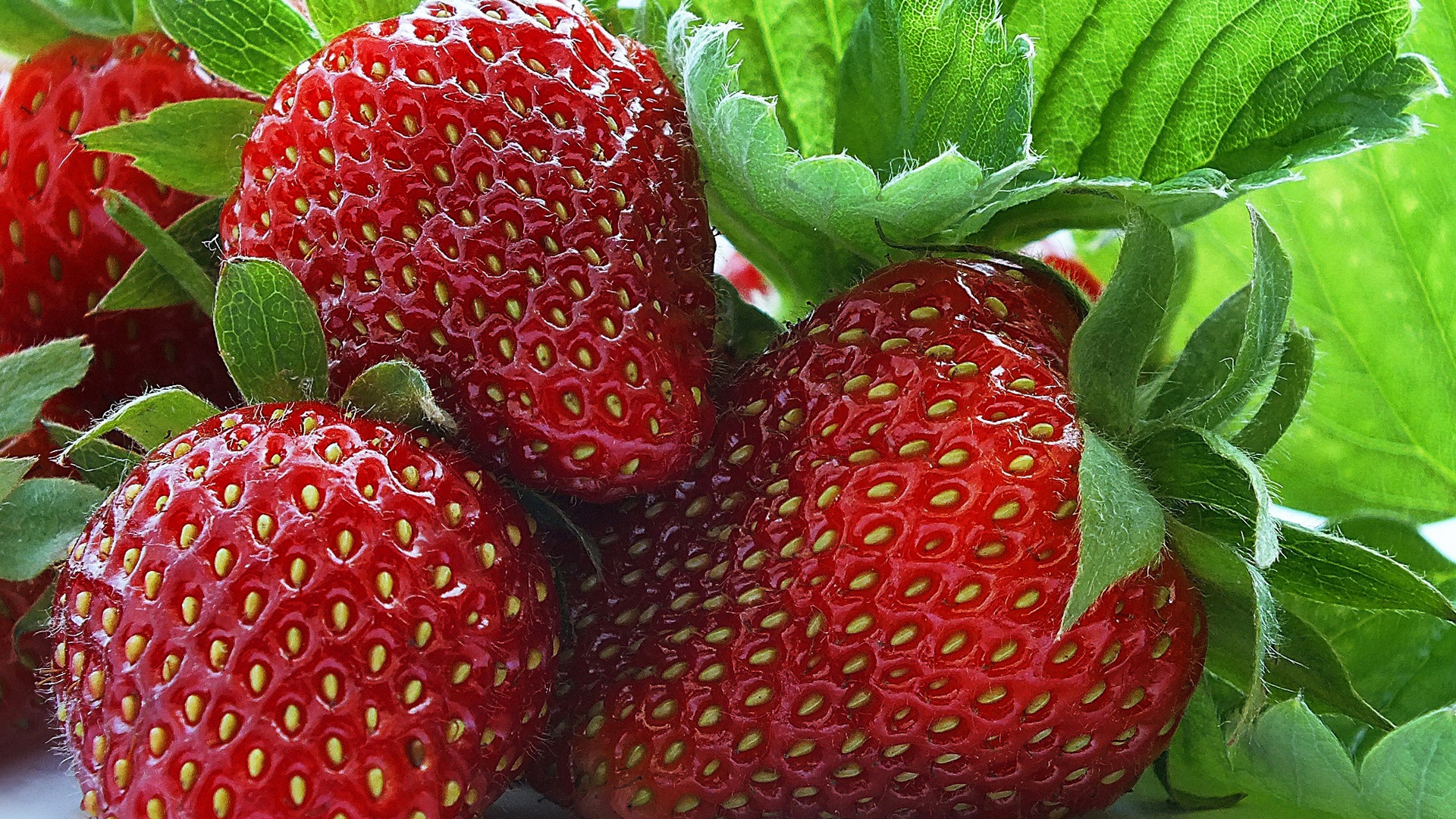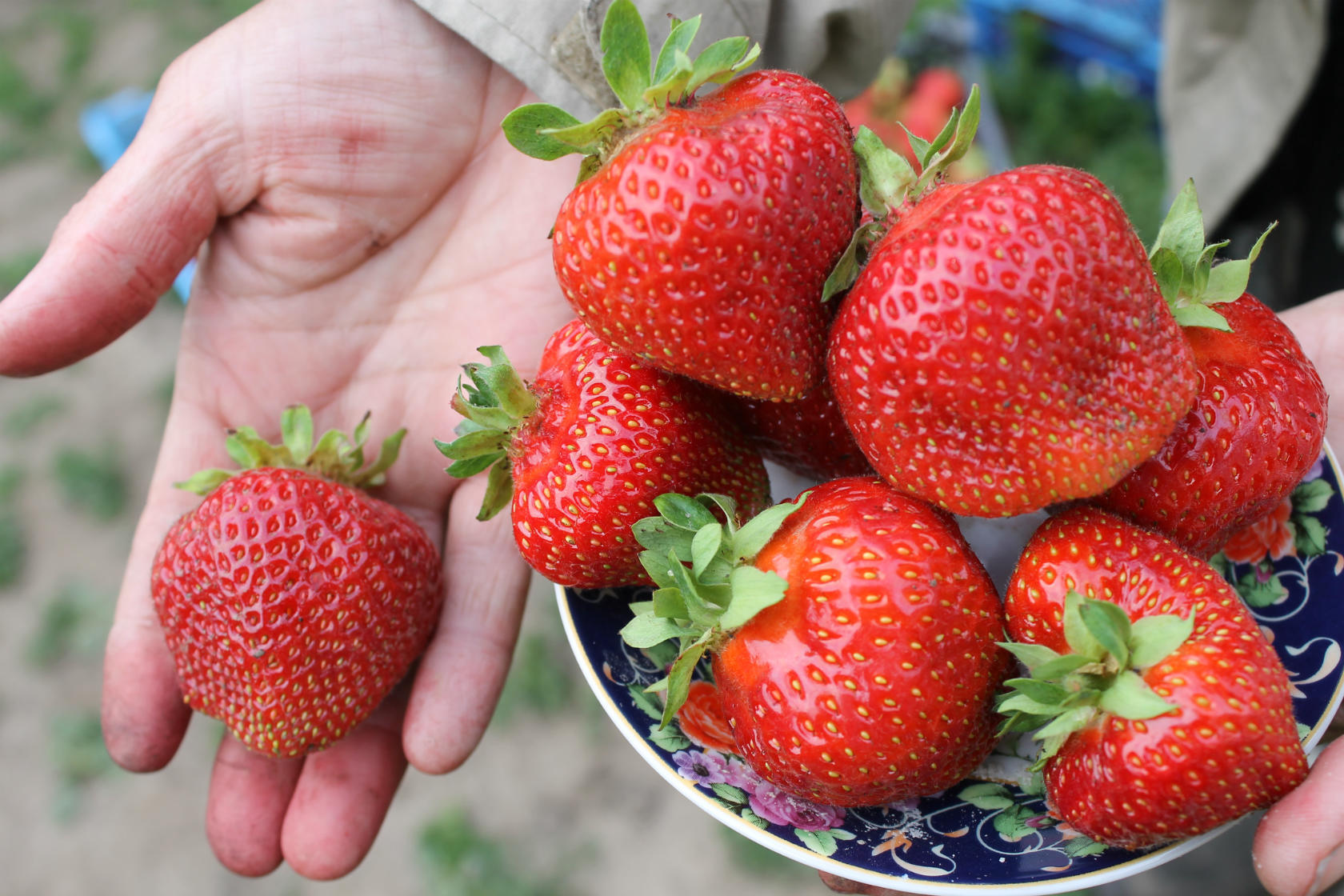Planting for a plant is the most important and crucial moment. Strawberries and strawberries differ in that, with all the huge abundance of species and planting methods, they have certain requirements for the conditions that are important to comply with.
Content
Where to plant strawberries
When growing strawberries (strawberries), it is extremely important to choose the right place, because the size of the yield directly depends on how suitable the selected area is for the plant.
| Site selection criterion | Indicator |
| Attitude to light | Light-loving culture. |
| Required amount of direct sunlight | about 8 hours a day. |
| Depth of groundwater | Not higher than 80 cm and not deeper than 150 cm. |
| Orientation of the beds | Strictly from north to south. |
| Allowable slope steepness | 1.5º-5º. |
| Attitude to the wind | Sharply negative, does not like cold air currents and its stagnation. |
| Crops after which strawberries cannot be planted | Solanaceous and Asteraceae crops, as well as cabbage and zucchini. |
| Crops after which it is recommended to plant strawberries | Carrots, turnips, radishes and green manure plants such as alkaloid lupine and white buckwheat. |
| The best neighbors of strawberries | Garlic, parsley and all members of the Legume family. |
| Preferred soil | Medium - or light loamy, as well as sandy loam. |
| Soil acidity | 5,5–8 |
| Soil moisture | 70–80% |
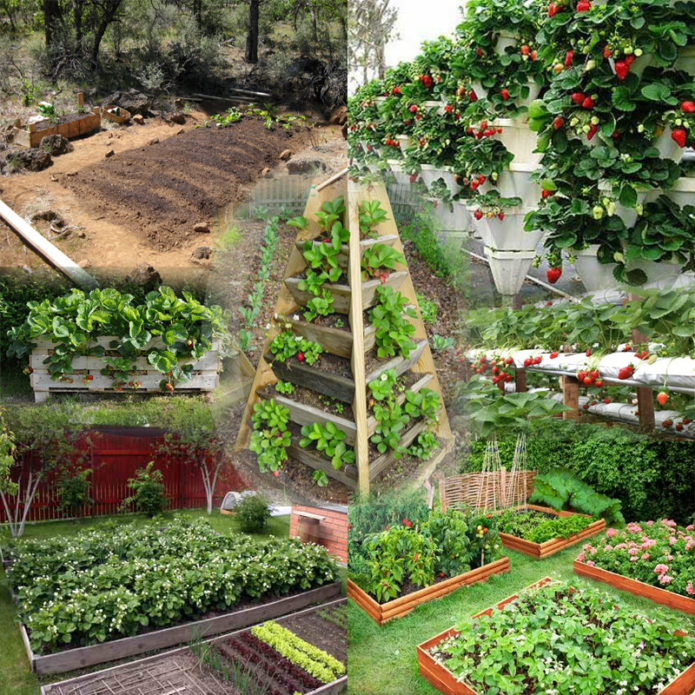
The basic rules for choosing a place for planting must be observed regardless of the method and method of planting strawberries (strawberries)
When to plant strawberries
There are three times when you can plant strawberries in your garden.
- At the end of summer, when the majority of berry-growers have already finished bearing fruit, you can just plant strawberries, you just need to remember about the importance of observing the correct crop rotation for this culture.
- From September 1 to September 20, the most favorable time for both preparing the soil for fallow for the winter, and for the very planting of strawberries. But if the soil does not meet the requirements of this berry, then in the fall it is better to carry out work to improve the soil, and postpone the planting itself until spring.
- Spring planting of strawberries is done in different regions at different times, because the earth warms up differently everywhere. But in any case, the planting itself can be done only when the threat of soil frosts disappears and the soil substrate warms up to 15–20ºС.
It should be noted that the soil for spring planting is prepared almost always in the fall.
How to plant strawberries
Before planting strawberries, the gardener needs to attend to the correct preparation of the soil. Many people use ready-made potting mixes specifically for strawberries, but if you wish, you can make up your own potting soil.
The soil for strawberries should be rich in organic compounds, therefore, either manure, or neutral high peat, or rotted compost in an amount of 8-10 kg per m2 is added to the used soil a week before planting (or in general, in autumn). And also be sure to put from 15 to 30% (proportions depend on the amount of clay in the soil) sand or perlite, in rare cases, you can use vermiculite - this will reduce the likelihood of plant decay.
Even during planting, a certain set of mineral fertilizers must be added.
| Fertilizer | Proportion (calculated per m²) |
| Double superphosphate | 40 g |
| potassium sulfate | 20 g |
| wood ash | 5 Kg |
But do not forget that when carrying out various works to improve the properties of the soil, such as deoxidizing the soil with lime, the proportions of fertilizers may change in accordance with the changes made.
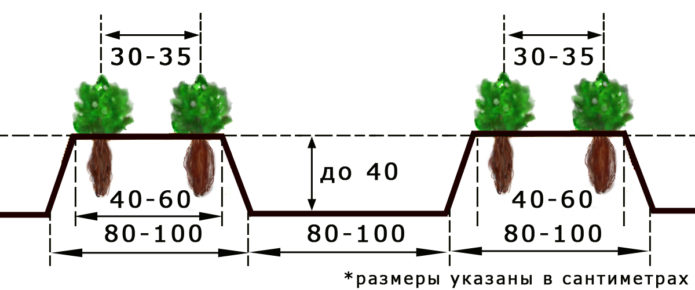
Almost all strawberry varieties are planted using this method, only for some small-fruited varieties they use a different scheme (20 * 30)
The landing itself obeys a simple order:
- We make holes up to 35 cm deep, when planting formed plants with an open root system, or along the height of an earthen coma, and immediately pour in a little water there.
- We lower the seedling into the hole so that the root collar is immersed in the ground strictly half.
- We fill the hole with earth or a pre-prepared substrate.
- We ram the ground around the bush with our fingers or fist.
- In some cases, the land around the bush is mulched (depending on the planting method).
- Watering.

Note that the root collar of the plant plunges into the ground strictly in half, and this is extremely important, because if it is incorrectly positioned, the plant can either dry out the roots or rot
A person who is first engaged in planting plants in the ground, most likely, will not notice the difference. Indeed, planting strawberries in the ground is outwardly similar to planting other crops, but has its own key properties. So, the depth of the hole is determined by the long roots of the plant, which should hang freely without any bends. The place where the root bends will be susceptible to disease, and it is significant that you can lose not only the harvest of this season, but also the plant itself. The roots of an adult strawberry bush are 20 - 45 cm long.Many gardeners recommend shortening the root length, especially if it exceeds 35 cm.
After planting, the plants do not bother with watering for several days, because strawberries are very bad for both the excess moisture content in the soil and its lack. After planting seedlings in the ground, the next month, watering is carried out on average once a week. Then you can reduce the number of waterings to two or three per month. The roots of strawberries are especially sensitive in the first month after planting, both to the amount of moisture and to its temperature. In any case, watering is carried out either early in the morning or in the evening, at a time when the sun's rays, passing through the drops of water, cannot burn the leaves. Currently, three types of irrigation are used: manual (from a watering can), drip and sprinkler. It is drip irrigation that is gaining the greatest popularity. With this type of irrigation, moisture is supplied to the roots of each plant from a reservoir, which is filled in advance. This allows you not only to save water and adjust the time and frequency of watering, but also to monitor the temperature of the water. Strawberries should not be watered with cold water, as well as strongly overheated water - this can lead to the development of diseases, burns and death of the plant. In addition, during flowering, the plant needs additional irrigation.
Factors influencing the successful planting of strawberries:
- Selection and storage of seedlings.
- Soil preparation and timing.
- Compliance with the order of planting.
- Compliance with the technology of the selected landing method.
- Watering for the first four weeks after planting.
Video: planting strawberries in autumn
Storing strawberry seedlings in winter
There are several technologies for storing seedlings, but the most common is to store planting material in boxes, the bottom of which is lined with slightly damp moss. From above, the seedlings are covered with lids with small ventilation holes. The room where the seedlings are stored should not only be ventilated, but also keep the temperature around 2-6 ° C warm.
Air requirements at the place where the seedlings are stored.
| Demand | Indicator |
| Air humidity | 90% |
| Carbon dioxide content | 5% |
| Oxygen content | 2,5% |
There are other technologies for storing seedlings, but they are not widely used among experienced gardeners. Long-term storage technology is also useful if the weather or the lack of prepared soil does not allow planting strawberries at the end of summer. Then the grown mustache or seedlings must be saved until spring.
Some gardeners prefer to treat plants with fungal agents just before placing them in the chamber.

When preparing plants for storage for a long time, the soil is carefully removed, the roots are straightened and the plants are collected in bunches
Any cooling method is able to maintain the vital parameters of strawberry seedlings for up to one year
Storage of seedlings in the apartment just before planting
If the planting material was purchased, but it is impossible to plant it right away, then you need to sprinkle the roots of the seedlings with earth and regularly water or spray them. The main thing is not to let the plant root system dry out. With this care, the seedlings will be able to hold out for 2-3 days.
Preparing seedlings and seeds for planting
Preparing seedlings for planting takes three steps.
- Examine the plant for diseased, rotten, or dry parts.
- Cut off all diseased, dry or rotten parts of the plant (both roots and leaves).
- For 10-15 minutes, immerse the root system in a solution of Kornevin, Humate or any other proven growth stimulator.
Seed preparation for planting is more difficult and time consuming. Usually strawberry and strawberry seeds have a low germination rate. It will be influenced by how long and in what conditions the seeds were stored. In any case, planting material with an expired shelf life (it is always indicated on the package) will have a low germination capacity. To increase the number of seedlings, seeds are treated before planting. To begin with, the seeds are dipped for 10-15 minutes in a weak solution of potassium permanganate, then dried on a clean, dense cloth. The density of the cloth is important, because the seeds are comparable in size to the tip of a toothpick.
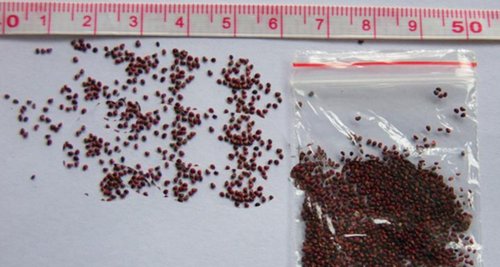
Even in large varieties of strawberries (strawberries), the seeds are extremely small, so most often they use a toothpick to plant them.
Immersion in a solution of potassium permanganate not only makes it possible to neutralize pathogens, but also to stimulate growth. After potassium permanganate, slightly dried seeds are soaked in water or in a solution of Kornevin or Humate, or another biological stimulant. The time of soaking in solution depends on the instructions on the biostimulant packaging. If water is used, then for 3-4 hours. The treated seeds are immediately planted for germination.
Different ways of planting seedlings
Sowing seeds for seedlings (as indicated on the seed package) is recommended to start in February. But if it is possible to provide illumination 12-14 hours a day and a stable temperature in the region of 16-22 ° C, then you can sow seedlings in January. If the seedlings are placed on a windowsill, then it is preferable to choose the southern or southeastern side. The prepared seeds are sown in specially prepared places. It can be:
- small boxes for seedlings;
- separate cassettes or pots;
- landing in "snails";
- pills.
In the first three cases, a specially prepared soil substrate is necessarily sterilized. For planting in peat tablets, you need to prepare sand, which is also desirable to sterilize.The sand is sterilized in order to remove the seeds of other plants and possible pathogens. To do this, it is calcined on a pan in the oven in one of two ways. Or 1 hour at 1200C with periodic stirring after 10-15 minutes, or half an hour at a temperature of 1500With the same mixing interval.
The most traditional seeding method is box or container seeding. Previously, they used packages from milk, kefir, sour cream and fermented baked milk. They were thoroughly washed to remove grease and trimmed to the desired size if necessary. Now this need has disappeared, since you can buy many different containers for specialized purposes. It is important to understand that the seeds of strawberries or strawberries are very small, the seedlings before the first pick will be comparable in thickness to a hair. Difficulties will arise with transplanting into separate pots. Therefore, sprouting in a common container has become less and less frequent.
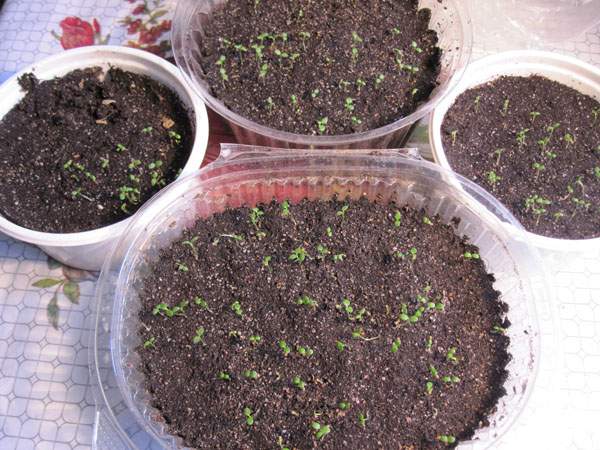
When planting seeds in a common container, pay attention to the height of the sides, they should not be high
Sowing seeds in separate cassettes or pots differs in that each seed is sown in a separate container.
For growing seeds of strawberries or strawberries, it is better to take small cells - 3 * 3 cm at a depth of 4-6 cm. Cassettes and cups can also be used for planting seedlings grown in tablets. This is done in cases where the sprouts have already begun to germinate the tablet shell, and it is too early to plant them in open ground.
Snail planting is a very effective new method of growing seedlings. It is based on rolling up a soft substrate material, which is 10 cm wide, together with a thin layer of soil substrate, 1 cm thick.
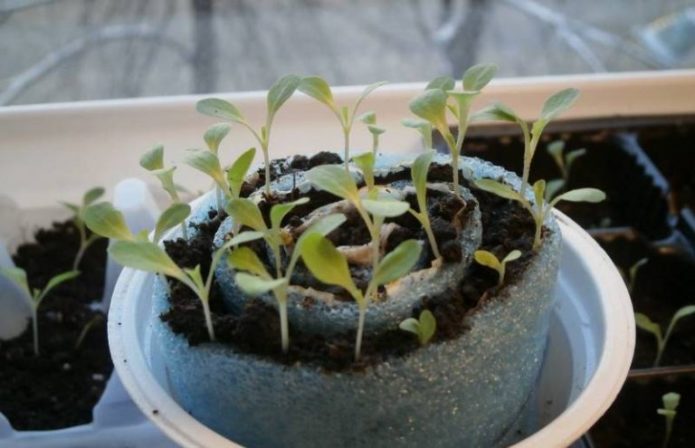
The seeds themselves are added to the surface of the substrate with a brush or toothpick after the snail has been rolled
Planting seeds in tablets.
Today, there are two types of tablets on sale: peat and coconut. Before buying, you need to make sure that all the tablets are packed in a mesh, then they will not fall apart during use. Before use, they are soaked as indicated on the package. Then you can plant seeds.

Planting seeds in tablets by experienced gardeners is carried out using a toothpick into the holes prepared by the manufacturer
Tablets have their own advantages:
- Peat and coconut are specific substrates that do not contribute to the spread of diseases, which promotes the growth of healthy seedlings.
- Seedlings are planted in the ground directly with the substrate, which protects the roots from damage.
- Substrates conduct water well, without retaining its excess.
- Most importantly, both substrates allow air to pass through, which ensures good aeration for the roots.
According to most experienced gardeners, for planting capricious and expensive plants it is worth in coconut tablets, and the rest in peat tablets. For strawberry seeds, coconut is preferable, since they pass oxygen a little better than peat ones and are less likely to rot due to excess water. To reduce the risk of mold and crust appearing when the cassette dries, add half a coffee spoon of sterile sand to the swollen peat tablet and stir it with a toothpick. The addition of sand also makes it easier for the strawberry seeds to deepen, because they are placed in the depression and not sprinkled. Under the influence of moisture, the seeds themselves gradually sink into the substrate. No sand is needed for coconut tablets.

In practice, the development of mold is largely due to a poor quality substrate, therefore, when buying, you need to carefully consider the manufacturer
Which pill to choose depends more on the preferences of the gardener. In both cases, seedlings of strawberries or strawberries grow successfully and develop without picking until they are planted in the ground.
Regardless of the method of sowing seeds, they must be sprayed.Strawberry (strawberry) seedlings are very tender, so they are carefully sprayed, not watered. It is recommended for a novice gardener to pour water into the pan where the tablets are placed. In general, the next watering usually occurs about a week after planting, or even later (depending on soil moisture). Prior to this, future seedlings are loosely covered with transparent material. In everyday life, they use a loosely closed bag, or a transparent lid from the container. Recently, the use of micro-greenhouses has become actively used. This makes it easier to remove the accumulated excess condensate and ventilate the seedlings.
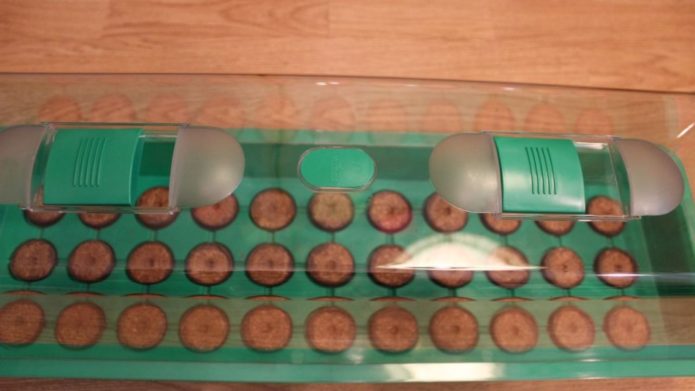
Micro-greenhouses, or as they call it, mini-greenhouses are of different sizes for different cassettes, which allows you to optimally select the one you need in each specific case
Seedlings will spend many days under a film, covering material or in a micro-greenhouse with periodic airing and spraying until two true leaves appear. Then the seedlings begin to harden. To do this, remove the lid not only to remove condensation and airing (3-5 minutes daily), but leave the plants open even longer, gradually increasing the time.
Landing in a hydrogel. Some gardeners mistakenly believe that the hydrogel can be used during the seed planting stage. They do not take into account the properties of this material. A hydrogel is a special polymer that is able to absorb and retain a large amount of moisture for a long time. Strawberries are very capricious in terms of the amount of water and quickly rots when there is an excess of it, so you cannot plant seeds in the hydrogel. They will just rot. Another thing is a strawberry mustache. For the development and formation of the root system, with the already existing upper part and root collar, a hydrogel can be useful. In such an environment, the mustache grows actively, but there is a danger of infection. If the roots of the seedlings were not washed and kept in potassium permanganate, then the aqueous medium of the hydrogel becomes a fertile environment for bacteria. Which will lead to the loss of both expensive material and the plant itself.
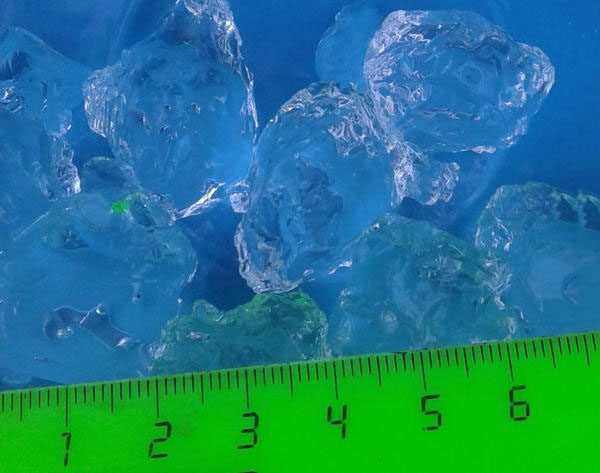
Remember that the hydrogel already contains many useful substances, so you should not pour hydrogen peroxide into it
Various outdoor planting methods
People have come up with many ways of planting strawberries in open ground, most of them are also decorative. And some are used for commercial purposes.
The most traditional method is considered to be planting with ribbons, which can be either double-leaf or single-line.
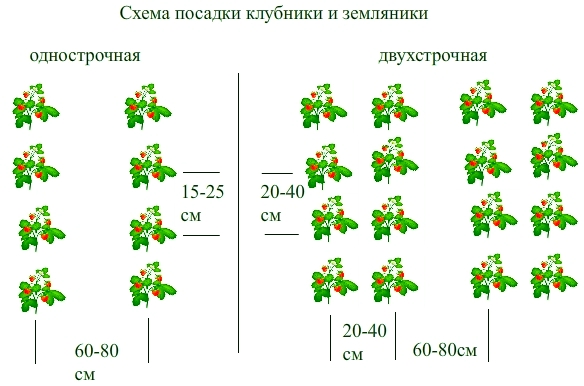
For this method of planting, it is necessary to dig up the selected area so that clear rows are formed, in which holes for strawberries are then formed
The downside of planting with ribbons was that, as a rule, the rows occupy a vast area, where half of the space is the voids between the plants. Because of this, such a landing is unprofitable in small areas.
The advantages of this planting method are the convenience of processing bushes and facilitating the collection of berries. Therefore, this method is often used to grow strawberries for commercial purposes.
Carpet planting of strawberries is one of the most common planting methods in the southern regions of Russia.

The checkerboard pattern and the distance to neighboring bushes of 25 cm are the basic principles of carpet planting
The disadvantages of this planting method are that, firstly, the picking of berries is greatly complicated by the density of planting, and, secondly, degeneration is characteristic of such strawberry berries. That is, for the first 2 years, the berry grows well, and then it needs to be transplanted to another place. And also, such a planting cannot be used when growing early maturing varieties, because you will have to spend a lot of effort on the constant pruning of the mustache.
The advantages of carpet planting are the unnecessary care and compactness of plantings. This method is also used in the cultivation of strawberries for commercial purposes, but it is extremely rare, because when picking berries can lose their commercial quality.
Planting in high beds is used mainly when the groundwater is close to the surface or if the soil does not have the level of fertility necessary for strawberries.
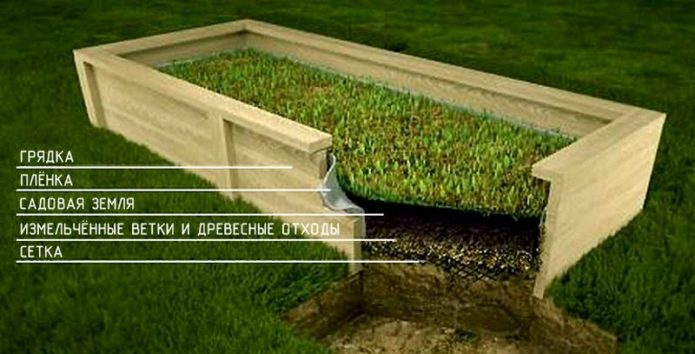
It is absolutely not necessary to make the frame of the garden from wood, slate, stone and metal will do.
The disadvantages of such beds are additional waste on materials for the frame and the requirement for frequent watering. Indeed, strawberries planted in this way will require more water because the land will dry out faster.
Such beds are becoming more and more popular with modern summer residents, because they have many advantages. The main advantages of this method are the extremely convenient processing of the beds, the ability to use a self-prepared soil substrate, the mobility of such beds (they can be easily disassembled and moved) and in their neat, beautiful form. Such beds are often used for decorative plantings.
High beds do not have a strictly defined height, so the gardener can decide for himself how much to raise the bed, but you must always remember that the higher the bed, the more the soil dries in it.
Tall beds have several non-standard varieties.
A bed of strawberries is the same high bed, only decoratively decorated, small in size and unusual in shape.
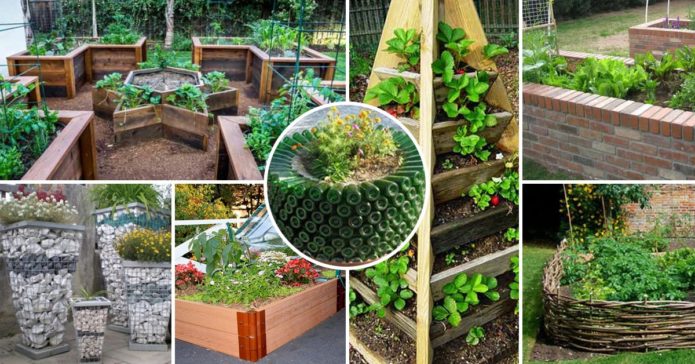
When it comes to flower beds, do not limit your imagination, the main thing is to comply with the conditions for selecting a place and soil substrate for strawberries
Strawberries, especially ampelous, are often planted in such a variety of tall beds as a pyramid.
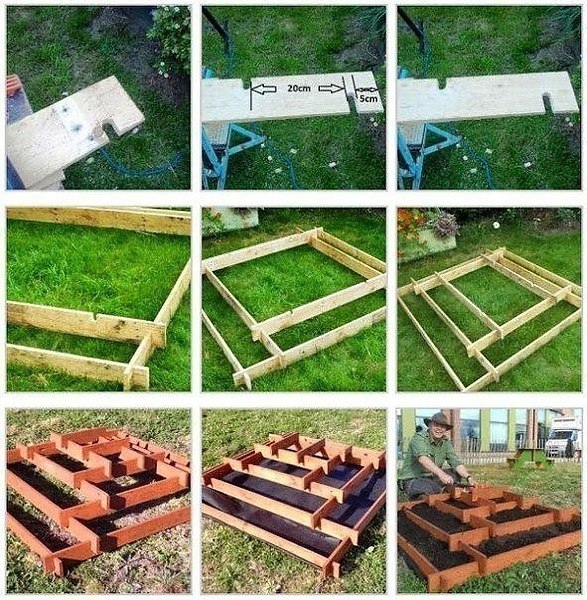
Each gardener determines the number of tiers of the pyramid for himself, but the principle of filling with earth is the same as for all standard high beds
Ridges are also non-standard high beds, because they follow the principle of adding a new soil substrate and forming a kind of bed from it. This planting method is suitable for those summer residents whose soil substrate is not quite suitable for strawberries. For example, the soil for some reason does not have an upper layer filled with humus and other organic compounds, then it is easier to artificially create this layer using ridges. This planting method is suitable for all varieties of strawberries and strawberries.
How to increase the yield of strawberries planted outdoors
In order to increase the yield of strawberries and increase the overall fertility of the soil, there are two proven ways:
- When planting and fertilizing, use straw or semi-rotten hay, which has an antibacterial effect and prevents the strawberry bushes from getting sick. And if, after planting, the soil is also mulched with straw, then the likelihood of berry rotting will decrease.
- Planting strawberries on spunbond or black foil primarily helps the plants by preventing weeds from growing. And this method also promotes the growth of large berries due to the low evaporation of water from the soil. The method is only available when forming ridges or high beds. First, the beds are formed, then they are watered with water and allowed to breathe a little, and then they are tightened tightly with a film or spunbond, the edges of the material are pressed to the ground with wooden slats or sprinkled with soil. The final step is to cut holes 5–8 cm in diameter in the film (or spunbond), where the seedlings are planted.
Black spunbond or agrofibre - nonwoven fabric, due to its porous structure, is more breathable than film, therefore it is rapidly gaining popularity. Weeds do not grow under it, just like under the film, but just like straw it does not need to be removed for the winter. Due to its color, it contributes to better warming up of the garden in spring and reduces the risk of damage to plants from recurrent frosts.When using straw, you can plant in any way (line, field or high beds), when using film or spunbond, the width of the beds will be limited by the width of the material minus 20 - 30 cm (the material must fit the sides and be attached) and the bed must be raised.
Planting strawberries in a greenhouse
Before growing strawberries, it is important to decide which greenhouse it will grow in. There are three types of greenhouses: frame, glass and polycarbonate.
Frame greenhouses are cheap and easy to build, but it is difficult to provide additional heating and lighting in them in winter, especially in the middle lane. Therefore, frame greenhouses can be used to start harvesting in May, but they are not suitable for year-round strawberry cultivation.
Although glass and polycarbonate greenhouses are more expensive, it is much easier to create conditions for year-round cultivation of tasty berries in them.
To plant strawberries for year-round cultivation, you need to take self-pollinating remontant varieties. In greenhouses, beds can be placed both horizontally and vertically. The vertical arrangement will not only allow better illumination of the plants, but also increase the number of plantings. How to arrange and in what to grow (in bags, containers or just beds), each gardener decides for himself, but it is impossible to violate the rules for selecting a soil substrate and the planting technique itself. It is important to remember that strawberries do not like drafts and strong stagnation, therefore they need proper ventilation while maintaining the microclimate. Maintaining humidity at 70–80% improves the quality of the berries, but carries the risk of diseases. In greenhouses, the use of substandard or contaminated soil will not allow a good harvest.
The best irrigation method in greenhouses is drip irrigation.
To get a good harvest, you need to maintain a light regime in the region of 12-14 hours. Year-round cultivation of strawberries is most often used for commercial purposes, but gardeners often use early planting in a greenhouse to harvest in May. In these cases, horizontal horizontal beds (Russian technology) or vertical (Dutch technology) are filled with seedlings of mature plants in February-March. The planting time determines the ability to maintain the temperature in the greenhouse in the region of + 20º-22ºС. In unheated greenhouses, it is better to do this at the end of March or even April, because strawberry bushes may not survive a temperature drop below -5 ° C. It is difficult to buy seedlings for such an early planting at this time, but it is not difficult to get boxes with mature plants prepared in advance from the cellar.
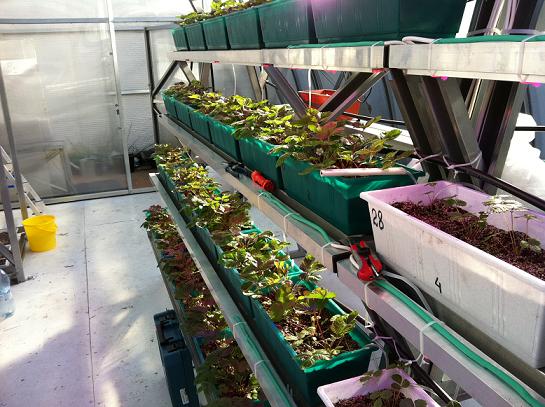
For growing efficiency, you can install racks in the greenhouse on which all plants will get the same amount of sunlight.
There is one more feature of growing strawberries in a greenhouse - it is the ability to plant plants in containers of any configuration.
Various indoor planting methods
Strawberries can be grown both in an apartment and in small areas by planting in different containers.
For example, you can plant strawberries in pots, flowerpots or flowerpots and decorate windowsills or balconies with them.
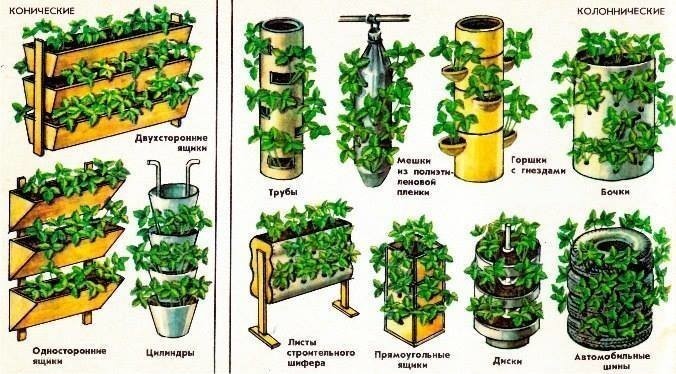
When planting in a container of any configuration, you must always add gravel or expanded clay so that there is no decay
When choosing a container for planting strawberries, make sure that it has special holes for draining water.
Often strawberries are planted in tires, when choosing such a container, it should be remembered that black rubber tends to overheat and drain the soil. But nevertheless, there are not a few gardeners who plant seedlings of this berry crop in tires, because this method has several advantages.Firstly, when planting in tires, you do not need to dig out anything and take into account the initial soil conditions, because you can use a ready-made soil substrate. Secondly, the design of the tires itself is extremely mobile, that is, if desired, it can be easily disassembled and moved to another place. And finally, the tires themselves can be painted or decorated, which will give them the appearance of a decorated flower bed.
Recently, many shops and nurseries began to sell nylon bags in which you can plant strawberries.
But the most unusual planting method is vertical PVC pipes. To implement this method, you should take PVC pipes and at the same distance (about 20 cm) drill holes in them with a diameter of no more than 15 cm, and close the bottom of the pipe with a plug. Next, we prepare a rigid hose, in which we also make holes of only a small size and wrap this structure in burlap, tightly fixing it with twine. We place the wrapped hose in the previously prepared pipe. First, we fill the pipe with coarse gravel or crushed stone, then we load the soil substrate (black soil - 60%, high-moor peat -25% and perlite, you can use sand - 15%).
It is important to ensure that the hose is in the middle of the pipe when loading soil.
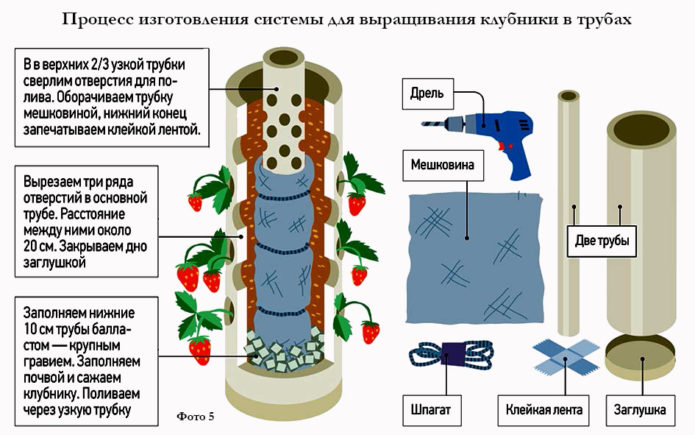
Unforgettable, to place in the middle of a large pipe a rigid hose with a small number of holes for irrigation
To grow strawberries indoors, you need to prepare the soil substrate.
Growing strawberries hydroponically
The hydroponic method of growing strawberries is a method in which the plant is placed not in the soil, but in a special artificial environment. There are several hydroponic methods for growing strawberries.
- There is a method of feeding N.F.T. nutrient solution, which circulates through pipes and enriches the plants sitting in the trays.
- The method of growing strawberries in aquatic culture involves planting the plant in polystyrene foam, which is dipped in a nutrient solution. But this method is characterized by frequent diseases of the bushes.
- And the most unusual method is the fog method. The roots of the plant are placed in a container connected to a special mist generator that creates a special nutritious aerosol.
Planting strawberry mother liquor
Planting a mother plant is an extremely painstaking business, because it requires complete isolation of the planted plants from other strawberries. Before planting, the soil of the mother liquor must be checked for stem nematode.
The mother plant is used only for breeding elite seedlings of unique varieties.
Features of planting ampelous and remontant strawberries
Ampelous strawberries have several planting features:
- Ampel strawberries are planted only on a hill (albeit small) or on high beds (a pyramid is best suited).
- Before planting, the roots of ampelous strawberry seedlings are dipped in an antiseptic, which can be a solution of copper sulfate and sodium chloride.
- Ampel strawberries are planted according to the scheme of 50 cm row spacing and 30 cm between plants, naturally, when planting in a pyramidal bed, seedlings are placed only in one row.
The cultivation of remontant strawberries, in turn, differs from the cultivation of other varieties only in that it is better to plant it in the spring and using the ribbon or carpet method.The rest of the planting of remontant strawberries is the same as the usual one.
Summarize. Whatever type of planting or its method is used, it is important to remember that strawberries are demanding for the correct orientation to the cardinal points. She is very susceptible to moisture and feeding. If all the basic rules are followed when planting, then no matter which method is used, the harvest will be consistently good.
